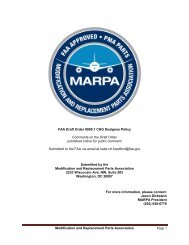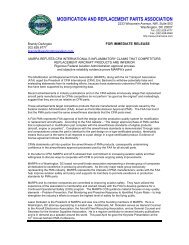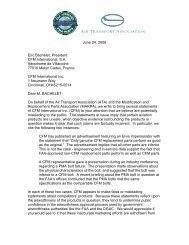Comments - MARPA
Comments - MARPA
Comments - MARPA
You also want an ePaper? Increase the reach of your titles
YUMPU automatically turns print PDFs into web optimized ePapers that Google loves.
whereby certain components could be more easily added to a repair station’s operations<br />
specifications over an equivalent PMA component, creating a de facto preference for OEM<br />
parts.<br />
An Alternative to the Ratings System<br />
The FAA has made numerous formal and informal proposals to update the ratings system over<br />
the past decade-and-a-half. None of them have been useful. The time may be ripe to consider<br />
a different approach.<br />
One radical option would be to do away with the rating system entirely. If the FAA policymakers<br />
believe that repair stations that work on avionics, instruments, appliances, etc. should<br />
rely on capabilities lists in order to identify the articles that they are qualified to maintain (which<br />
has been the modern trend), then perhaps we should do away with an admittedly out-of-date<br />
rating system and simply embrace capabilities lists for all repair stations as the replacement to<br />
the current rating system. This would permit repair stations to explain what they are capable of,<br />
with specificity, without that capability being interpreted in the light of an admittedly outdated<br />
and increasingly irrelevant ratings system.<br />
One problem that could be solved by such a move would be the problem of ratings<br />
reinterpretation (FAA policy interpretations of ratings that narrow their apparent scope, without<br />
providing repair stations with adequate notice that they need to change their ratings to continue<br />
to reflect their normal business practices). A related problem that would be resolved is the<br />
repair station that is 100% qualified to perform work (they have the right housing, tooling,<br />
equipment, data, personnel, training, etc.) but that finds it has inadvertently violated its rating<br />
because (1) the ratings were not updated to reflect the new scope of work or (2) a later<br />
inspector had a different interpretation of the limits of the stated ratings (we have seen this arise<br />
even where the FAA approved manual changes that supported the expansion of the business<br />
capabilities). By doing away with ratings, repair station would not have to worry about modifying<br />
multiple documents when they add capabilities – so the documentation burden associated with<br />
business practice changes would be minimized without any adverse effect on safety.<br />
This would also allow better organic growth of repair stations. A repair station with significant<br />
Cessna 172 business might have an airframe rating. From a business perspective, an<br />
investment in the capabilities to work on Lycoming IO-360 engines (a common engine on<br />
Cessna 172 aircraft) would make sense. The repair station might want to invest in additional<br />
tooling and trained personnel, but it might be able to obtain engine maintenance data from<br />
existing owner/customers. Under the existing system, this would be a significant step, requiring<br />
a totally different rating. But for a repair station that is able to perform a self-audit and verify its<br />
investment in the capability to work on such engines, it ought not to be such a significant step.<br />
The existing capabilities list system ought to be adequate to ensure that the repair station’s<br />
ability to work on the engines would be sufficiently documented to be reviewed by the FAA at<br />
the FAA’s discretion.<br />
Modification and Replacement Parts Association Page 10








